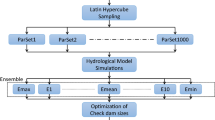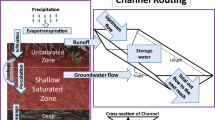Abstract
Hydrological modeling has provided key insights into the mechanisms of model state, such as the watershed partitioning level and optimization algorithm, and their impacts on the hydrological process, but the uncertainty of this impact is poorly understood. To this end, in this study, the effects of the watershed partitioning level and optimization algorithm for hydrological simulation uncertainty were assessed based on the semi-distributed TOPMODEL model, i.e., six watershed partitioning levels and three intelligent global optimization algorithms were used in the source region of the Yellow River. Meanwhile, the uncertainty contribution of the individual and interaction of the watershed partitioning levels and optimization algorithms on the hydrological process were dynamically evaluated using the variance decomposition method based on subsampling. Results showed that the impacts of the watershed partitioning level and optimization algorithm on the runoff simulation were particularly obvious for different characteristic periods. In the flood period, the optimization algorithm was the dominant factor affecting the runoff simulation uncertainty, with the proportion of up to 0.50, whereas the contribution of the watershed partitioning level was only 0.22. In the non-flood period, they contributed substantially to the uncertainty of the runoff simulation, accounting for about 0.30. Moreover, the interactions between the watershed partitioning level and optimization algorithm had a strong influence throughout the year, especially in the non-flood period, which may be because the hydrological model amplifies the output error and increases the interaction effect. Generally, the results shed important insight into reducing the uncertainty of the runoff simulation in future research.









Similar content being viewed by others
References
Arabi M, Govindaraju RS, Hantush MM, Engel BA (2006) Role of watershed subdivision on modeling the effectiveness of best management practices with SWAT. J Am Water Resour As 42(2):513–528
Arsenault R, Poulin A, Cote P, Brissette F (2014) Comparison of stochastic optimization algorithms in hydrological model calibration. J Hydrol Eng 19(7):1374–1384
Beven K (1979) On the generalized kinematic routing method. Water Resour Res 15(5):1238–1242
Bosshard T, Carambia M, Goergen K, Kotlarski S, Krahe P, Zappa M, Schär C (2013) Quantifying uncertainty sources in an ensemble of hydrological climate-impact projections. Water Resour Res 49(3):1523–1536
Burgan HI, Aksoy H (2020) Monthly flow duration curve model for ungauged river basins. Water 12(2):1–19
Chang JX, Meng XJ, Wang ZZ, Wang XB, Huang Q (2014) Optimized cascade reservoir operation considering ice flood control and power generation. J Hydrol 519:1042–1051
Chang JX, Wang YM, Erkan I, Bai T, Huang Q, Yang DW, Huang SZ (2015) Impact of climate change and human activities on runoff in the Weihe River Basin, China. Q Int 380–381:169–179
Chen Y, Xu CY, Chen XW, Xu YP, Yin YX, Gao L, Liu MB (2019) Uncertainty in simulation of land-use change impacts on catchment runoff with multi-timescales based on the comparison of the HSPF and SWAT models. J Hydrol 573:486–500
Cheng CT, Ou CP, Chau KW (2002) Combining a fuzzy optimal model with a genetic algorithm to solve multi-objective rainfall–runoff model calibration. J Hydrol 268(1–4):72–86
Cuo L, Zhang YX, Gao YH, Hao ZC, Cairang LS (2013) The impacts of climate change and land cover/use transition on the hydrology in the upper Yellow River Basin, China. J Hydrol 502:37–52
Duan QY, Sorooshian S, Gupta V (1992) Effective and efficient global optimization for conceptual rainfall–runoff models. Water Resour Res 28(4):1015–1031
Eberhart RC, Kermedy J (1995) A new optimizer using particles swarm theory. In: Proceedings of the 6th international symposium on micro machine and hmm science, Nagoya, pp 39–43
Eckhardta K, Arnoldb JG (2001) Automatic calibration of a distributed catchment model. J Hydrol 251(1–2):103–109
Gan YJ, Liang XZ, Duan QY, Ye AZ, Di ZH, Hong Y, Li JD (2018) A systematic assessment and reduction of parametric uncertainties for a distributed hydrological model. J Hydrol 564:697–711
Gao ZL, Zhang L, Zhang XP, Cheng L, Nick B, Tim C, Cai WJ (2016) Long-term streamflow trends in the middle reaches of the Yellow River Basin: detecting drivers of change. Hydrol Process 30(9):1315–1329
Gupta HV, Kling H, Yilmaz KK, Martinez GF (2009) Decomposition of the mean squared error and NSE performance criteria: implications for improving hydrological modelling. J Hydrol 377(1–2):80–91
Han JC, Huang GH, Zhang H, Li Z, Li YP (2014) Effects of watershed subdivision level on semi-distributed hydrological simulations: case study of the SLURP model applied to the Xiangxi River watershed, China. Hydrol Sci J 59(1):108–125
Huang SZ, Chang JX, Huang Q, Chen YT (2014) Monthly stream flow prediction using modified EMD-based support vector machine. J Hydrol 511:764–775
Jha M, Gassman PW, Secchi S, Gu R, Arnold J (2010) Effect of watershed subdivision on SWAT flow, sediment, and nutrient predictions. J Am Water Resour As 40(3):811–825
Jiang Y, Liu CM, Li XY, Liu LF, Wang HR (2015) Rainfall–runoff modeling, parameter estimation and sensitivity analysis in a semiarid catchment. Environ Model Softw 67:72–88
Jie MX, Chen H, Xu CY, Zeng Q, Tao XE (2016) A comparative study of different objective functions to improve the flood forecasting accuracy. Hydrol Res 47(4):718–735
Joseph JF, Guillaume JHA (2013) Using a parallelized MCMC algorithm in R to identify appropriate likelihood functions for SWAT. Environ Model Softw 46:292–298
Khakbaz B, Imam B, Hsu K, Sorooshian S (2012) From lumped to distribute via semi-distributed: calibration strategies for semi-distributed hydrologic models. J Hydrol 418–419:61–77
Kim JG, Park Y, Yoo D, Kim NW, Engel BA, Kim SJ, Kim KS, Lin KJ (2009) Development of a SWAT patch for better estimation of sediment yield in steep sloping watersheds. J Am Water Resour As 45(4):963–972
Koçyiğit MB, Akay H, Yanmaz AM (2017) Effect of watershed partitioning on hydrologic parameters and estimation of hydrograph of an Ungauged basin: a case study in Gokirmak and Kocanaz, Turkey. Arab J Geosci 10(15):1–13
Larose M, Heathman GC, Norton LD, Engel B (2007) Hydrologic and atrazine simulation of the cedar Creek watershed using the SWAT Model. J Environ Qual 36(2):521–531
Li BQ, Liang ZM, He YQ, Hu L, Zhao WM, Acharya K (2017) Comparison of parameter uncertainty analysis techniques for a TOPMODEL application. Stoch Environ Res Risk A 31:1–15
Liu S, Xu JW, Zhao JF, Xie XM, Zhang WC (2014) Efficiency enhancement of a process-based rainfall–runoff model using a new modified AdaBoost.RT technique. Appl Soft Comput 23:521–529
Liu JJ, Zhou ZH, Yan ZQ, Gong JG, Jia YW, Xu CY, Wang H (2019) A new approach to separating the impacts of climate change and multiple human activities on water cycle processes based on a distributed hydrological model. J Hydrol 578:1–12
Ma Q, Zavattero E, Du MX, Vo ND, Gourbesville P (2016) Assessment of high resolution topography impacts on deterministic distributed hydrological model in extreme rainfall–runoff simulation. Proc Eng 154:601–608
Manillapalli S, Srinivasan R, Arnold JG, Engel BA (1996) Effect of spatial variability on basin scale modeling. In: 3rd international conference workshop on integrating GIS and environmental modeling, Santa Fe
Norris G, Haan CT (1993) Impact of subdividing watersheds on estimated hydrographs. Appl Eng Agric 9(5):443–445
Qi W, Zhang C, Fu GT, Zhou HC (2016) Quantifying dynamic sensitivity of optimization algorithm parameters to improve hydrological model calibration. J Hydrol 533:213–223
Shi HY, Wang GQ (2015) Impacts of climate change and hydraulic structures on runoff and sediment discharge in the middle Yellow River. Hydrol Process 29(14):3236–3246
Tsoukalas I, Makropoulos C (2015) Multiobjective optimisation on a budget: exploring surrogate modelling for robust multi-reservoir rules generation under hydrological uncertainty. Environ Model Softw 69:396–413
Wang QJ (1991) The genetic algorithm and its application to calibrating conceptual rainfall–runoff models. Water Resour Res 27(9):2467–2471
Wang YC, Yu PS, Yang TC (2010) Comparison of genetic algorithms and shuffled complex evolution approach for calibrating distributed rainfall–runoff model. Hydrol Process 24(8):1015–1026
Wang TH, Yang HB, Yang DW, Qin Y, Wang YH (2018a) Quantifying the streamflow response to frozen ground degradation in the source region of the Yellow River within the Budyko framework. J Hydrol 558:301–313
Wang YG, Engel BA, Huang PP, Peng H, Zhang X, Cheng ML, Zhang WS (2018b) Accurately early warning to water quality pollutant risk by mobile model system with optimization technology. J Environ Manag 208:122–133
White LW, Vieux B, Armand D, Ledimet FX (2003) Estimation of optimal parameters for a surface hydrology model. Adv Water Resour 26:337–348
Xi ML, Lu D, Gui DW, Qi ZM, Zhang GN (2016) Calibration of an agricultural-hydrological model (RZWQM2) using surrogate global optimization. J Hydrol 544:456–466
Zeng Q, Chen H, Xu CY, Meng XJ, Chen J, Guo SL, Liu J (2018) The effect of rain gauge density and distribution on runoff simulation using a lumped hydrological modelling approach. J Hydrol 563:106–122
Zhang XS, Srinivasan R, Zhao KG, Liew MV (2009) Evaluation of global optimization algorithms for parameter calibration of a computationally intensive hydrologic model. Hydrol Process 23:430–441
Zhou S, Wang YM, Chang JX, Guo AJ, Li ZY (2018) Investigating the dynamic influence of hydrological model parameters on runoff simulation using sequential uncertainty fitting-2-based multilevel-factorial-analysis method. Water 1177(10):1–18
Zhou Q, Chen L, Singh VP, Zhou JZ, Chen XH, Xiong LH (2019) Rainfall–runoff simulation in Karst dominated areas based on a coupled conceptual hydrological model. J Hydrol 573:524–533
Acknowledgements
This work was supported by the National Natural Science Foundation of China (Grant Nos. 51679187, 51647112).
Author information
Authors and Affiliations
Corresponding authors
Additional information
Publisher's Note
Springer Nature remains neutral with regard to jurisdictional claims in published maps and institutional affiliations.
Rights and permissions
About this article
Cite this article
Zhou, S., Wang, Y., Guo, A. et al. Impacts of changes in the watershed partitioning level and optimization algorithm on runoff simulation: decomposition of uncertainties. Stoch Environ Res Risk Assess 34, 1909–1923 (2020). https://doi.org/10.1007/s00477-020-01852-7
Published:
Issue Date:
DOI: https://doi.org/10.1007/s00477-020-01852-7




